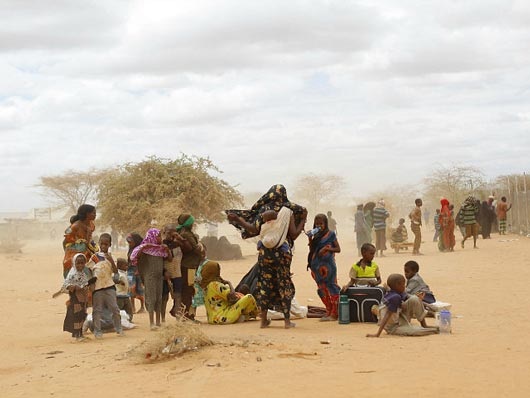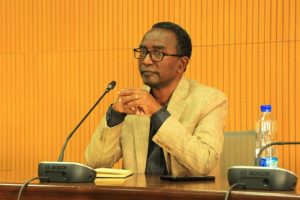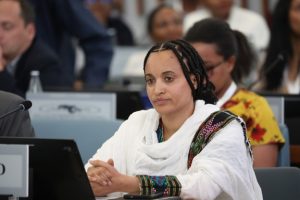
BY STAFF REPORTER
Ever since human society existed on earth people have been migrating from place to place due to many reasons good or bad. For many years, people used to leave their homes and refuge to different places when they encounter lack of peace, justice … etc.
In addition, people also migrate due to economic reasons. They travel to places where they can work and prosper more especially if their original places are resource scarce, economically poor and have no hope.
Currently, climate change is being added to the factors that aggravate migration. Hence, it is time for governments and international organizations to speed up their efforts of curbing climate change, keeping in mind this grave concern.
Although the SDGs do not explicitly link climate change and migration, SDG target 10.7 calls for signatories to “facilitate orderly, safe, and responsible migration of people, including through implementation of planned and well-managed policies.”
While the intensity and severity of climate-induced disasters and climate-related migration will be unevenly distributed across space and time, the World Bank estimates that approximately 140 million people will be displaced globally due to climate-related reasons by 2050. The effects of climate change are expected to be particularly pronounced in Africa, where rising temperatures, unpredictable anomalous rainfall and high vulnerability to extreme natural hazards will continue to exacerbate conflict and harm local and regional human, economic, and environmental security.
In the East and Horn of Africa (EHoA) in particular, the dependence on rain-fed agriculture and pastoralism means that livelihoods and food security are inextricably linked and affected by long-term or sudden environmental changes and natural hazards. The extreme natural hazards that have struck EHoA in recent years have caused widespread hunger, displacement, loss of critical infrastructure and livelihoods, and death.
The majority of Ethiopia’s nearly 110.000 million inhabitants are dependent on agriculture for their livelihoods. Accounts of Ethiopian migrants travelling to the Gulf, South Africa and towards Europe are already in circulation and many observers see the growing impact of climate change as having the potential to send many thousands more on similar journeys. Given these fears and their impact on global policies and politics, perhaps we need a better understanding of what is really going on.
Mobility by individuals and households is common practice and has been throughout history. Today, few remain stationary throughout their lives, whether in Denmark, Ethiopia or anywhere else. Mobility can be temporary or permanent, long-term or short-term, seasonal or in other ways periodic. Some might decide to move despite a wish to stay; while others might wish to move but are for various reasons held back.
In the histories of European countries, great periods of mobility were often linked to industrialization and the growth of commercial agriculture; many fewer in rural areas, many millions more in major urban centers. The economic growth occurring drew in labor from further afield, not least from countries linked through historical relations rooted in trade and colonialism, as domestic labour supplies proved insufficient.
The situation in developing countries is little different. Economic development needs a workforce, a workforce needs cheap food supplies, and agriculture needs to provide this food and an economic surplus that can feed into the new economic activities, whether through state tax-based investments or private capital flows.
According to the report by reliefweb.net, in Ethiopia, climate change has been experienced for a long time; there have been fifteen serious famines in the past 50 years alone. In the 1970s and 1980s, famine became militarized as first the government of Haile Selassie and later that of the Derg sought to defeat armed movements seeking their downfall in areas affected by famine. Populations were forcibly resettled, aid systematically denied, and aid organizations punished for providing support.
Today, many farmers and their families speak of having to travel further for water, of crop yields being reduced due to changes in temperature and precipitation, and food insecurity growing. Adapting to climate change requires far more than improved agricultural extension services, better water management, and social protection payments designed to offset some of the financial losses increasingly incurred. In such scenarios, mobility that accesses other sources of finance is a key instrument of adaptation.
IOMs’ Flow Monitoring Registry (FMR) captures a wealth of data about the migratory routes, the demographics and nationality of migrants, reasons for migration, modes of transportation used to facilitate movement, and vulnerabilities experienced by these populations. While the descriptive data provides a wealth of information, more can be done to analyze the complexities of and interactions between migration, conflict, environmental changes, and climate-related events. Climate projections further suggest that environmental changes will likely further lead to decreased water availability, lowered agricultural productivity, and increased disease transmission in the region, producing complex ramifications regarding local and regional conflicts, economics, politics, and migration.
According to recent reports of reliefweb.net, the porous borders in EHoA have contributed to some of the highest volumes of cross border movement in the world. In 2020 alone, EHoA hosted 6.5 million internally displaced persons (IDPs) and 3.5 million refugees and asylum seekers. In the same year, the Horn of Africa experienced unusually high levels of precipitation leading to disastrous floods and landslides and creating ideal conditions for a detrimental locust plague towards the end of 2019 that devastated crops and disrupted livelihoods.
The extreme precipitation experienced across much of the Horn in 2019 was preceded by anomalous rainfall the previous year. 2018 was particularly hot and dry in the Horn of Africa, with positive temperature anomalies of around 2°C and below-average precipitation contributing to drought-like conditions in Somalia, Eritrea, and Djibouti while Kenya and Sudan experienced above-average precipitation. The drought-like conditions in Somalia, Eritrea, and Djibouti contributed to widespread food insecurity that affected approximately 12 million people. These extreme weather conditions are increasingly exacerbating the already complex and interconnected factors driving migration in the Horn of Africa, and are only expected to escalate in the future.
For this study, the IOM RDH in Nairobi partnered with the Humanitarian Geoanalytics Program at the Harvard Humanitarian Initiative to leverage spatial analytics to investigate migration flows in the East and Horn of Africa and Yemen. Geospatial analytics holds tremendous potential to introduce new ways of thinking, build research capacity, study impacts, and facilitate cost effective programming. The adoption of geospatial methods into research oriented towards populations on the move, gives us the capacity to accurately characterize the spatial heterogeneity of migrating populations. Furthermore, by incorporating environmental variables into this spatial analysis, we begin to reveal relationships previously undiscovered that could contribute to a richer understanding regarding migration in the region.
THE ETHIOPIAN HERALD AUGUST 18/ 2021




